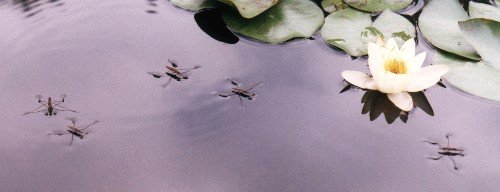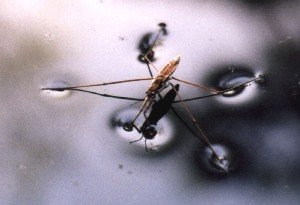Pond Skaters
by Valerie (August 5, 2001)
When we had only one small pond, I would sometimes see a tiny, slender, slow-moving insect that walked around on the surface tension. This was a water measurer. Most people have never seen one of these little predators since they are only about 1/2 inch long and extremely thin, blending in well with the dark vegetation in the pond.

On the other hand, everyone is familiar with water striders, or pond skaters. These fast, agile, predatory bugs are common on bodies of water everywhere. There are even marine species. Water striders spend their lives on the surface of the water or sometimes resting on solid surfaces nearby. We acquired one large water strider last spring with a batch of collected vegetation for our larger pond. For the whole summer, this lone insect could be seen darting about the open areas of water, balanced on the surface tension.
The water strider was still there this spring, but then I suddenly noticed that there was no big one anymore, but about 10 small ones. This little brood has been fascinating to watch, since their interactions are constant as they hardly ever hold still, and we always know where they can be found. At this time, there are at least 9 adult water striders, and several nymphs are visible every so often. I've watched the adults as they mate, eat prey and generally interact with each other. Mating begins quickly. There is a slight tussle for a few seconds as the two bugs get into position and then they remain that way for a long time. Water striders have 6 legs just like all insects, but the front two are very short and kept up in front of their head. Since there are just 4 obvious legs, when a mated pair is seen, it could easily be mistaken for a spider, with 8 outstretched legs. Some of the water striders in our pond have wings, although the majority certainly are wingless.
In their normal mode of locomotion, the water striders use their middle pair of legs (which are the longest) as oars to propel themselves forward. The back legs usually just help balance. When one comes to an obstacle, though, it jumps with alarming agility right over it, appearing to use all its legs to clear the water. I've seen the insects leap-frog over each other in this fashion. It looks very effortless because it disturbs the water surface so little.
Water striders are among the insects with simple, or gradual, metamorphoses. They don't go through a larval, pupa, then imago, or adult, stage, but instead just hatch out as nymphs, similar to the adult, that go through several molts until they are full grown. Each phase of the nymphs' growth is referred to as an instar. The first batch of water striders in our pond this summer grew amazingly fast. I would find their discarded molted shells all the time on the water surface. However, recently I've seen very few nymphs past the first instar stage, so I suspect they are unfortunate enough to be eaten by the hungry adults. While the water striders will skim away when I approach, they soon forget the intrusion if I remain still and I can watch them as they carry out their activities. Early in the morning, they move all over the pond, but later in the day, they tend to congregate in the shade. I saw one bug with a small insect that it had caught. It was in an unusually high position above the water and I suspect the reason was to keep its prey off the surface. The water striders use their front pair of legs to catch and hold prey, and as I watched one eating a small beetle that had fallen into the water, it tried to adjust its grip on the victim but suddenly became agitated. The reason was that a couple of strands of alga that had been attached to the beetle had dried over one of the water strider's front legs and it was now stuck. It went through all sorts of contortions to try and free itself. It finally succeeded, after rubbing the entangled leg against its second leg on the same side. There is one other small bug that lives on the surface of our pond. It is less than 1/8 of an inch long and the young are much smaller. This is the broad-shouldered water strider, related to the larger insects, but much different in form. It more closely resembles other true bugs, with a thick body and relatively short, equal-length legs. However, it can move very quickly. These tiny insects spend most of their time on the side of the pond right at the water's edge. If startled, they will skate rapidly along the surface, but seem to prefer the shelter of the dark wooden pond sides. |

